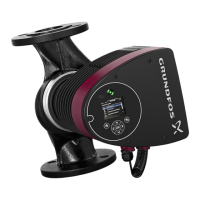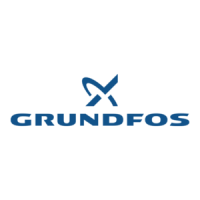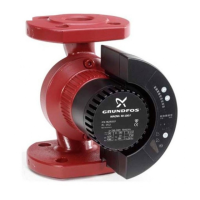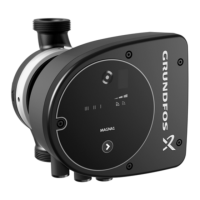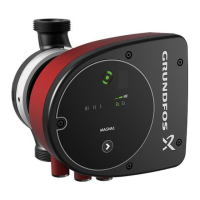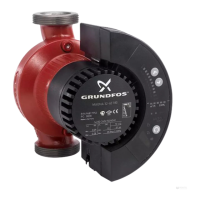Do you have a question about the Grundfos MAGNA3 Series and is the answer not in the manual?
| Temperature Range | -10 °C to +110 °C |
|---|---|
| Insulation Class | F |
| Series | MAGNA3 |
| Max. Liquid Temperature | 110 °C |
| Power Supply | 1x230V, 3x400V |
| Approvals | CE |
| Pump Housing | Cast iron |
| Installation | Inline |
| Communication | Modbus RTU, BACnet MS/TP |
| Ambient Temperature | 0 °C to 40 °C |
| Material | Cast iron |
Safety instructions not observed may result in personal injury or damage.
Safety instructions not observed may result in malfunction or damage.
Instructions to make job easier and ensure safe operation.
Details the systems for which the MAGNA3 pump is designed.
Specifies suitable liquids, water quality, and temperature limits.
Specifies operating temperature, pressure, ambient, and sound levels.
Notes necessary steps to prevent frost bursts when pump is not used.
Describes availability and fitting of insulating shells for pumps.
Explains ensuring pump discharge pressure is higher than valve closing pressure.
Details information provided on the pump nameplate.
Discusses wireless radio communication for remote control.
Lists recommended tools for installation.
Provides guidelines for indoor pump installation and cooling.
Explains correct pump installation orientation in vertical and horizontal pipes.
Details positioning requirements for the control box for adequate cooling.
Guides on fitting the pump head to the pump housing correctly.
Provides steps to change the control box orientation.
Lists available supply voltages and tolerances.
Step-by-step guide for connecting power to specific pump models.
Step-by-step guide for connecting power to model 32-XX pumps.
Illustrates typical electrical connections for the pump.
Details communication capabilities including relay outputs and digital inputs.
Explains connecting external sensors or signals for control.
Shows example electrical connections for external sensors.
Explains the priority of external control signals over panel settings.
Guides on setting the pump's setpoint for system matching.
Explains how to set the pump's operating mode (Normal, Stop, Min, Max).
Details various control modes like AUTOADAPT, FLOWADAPT, and constant modes.
Guides on enabling and setting the flow limit function.
Explains the automatic reduction of pump performance during night setback.
Details how relay outputs can be set for alarm, ready, or operation signals.
Explains how external setpoints and temperature influence the pump.
Details communication via bus systems and allocating pump numbers.
Covers general settings like language, date/time, units, and display.
Provides a step-by-step guide for completing pump setup.
Guides on setting the date and time, referencing section 13.9.2.
Assists in setting up a multi-pump system, referencing section 14.8.
Assists in setting up the analog input for external sensors.
Gives a short description of each control mode.
Provides information about faults and corrective actions.
Explains the multi-pump function for controlling multiple pumps.
Explains the meaning of indicator lights on the Grundfos Eye.
Describes center indicator light signals for Grundfos GO Remote communication.
Lists common faults, their causes, and corrective actions.
Provides detailed specifications for pressure and temperature sensors.
Details the features and usage of the Grundfos GO Remote app.
Explains pump communication via GENIair or CIM modules.
Provides instructions for installing a CIM module.
Details procedures for unpacking materials.
Provides guidelines for environmentally sound disposal of equipment.
Details the primary parts of the equipment.
Explains the working principle of the equipment.
Describes the semi-welded plate heat exchanger.
Outlines necessary requirements before starting installation.
Provides instructions and warnings for lifting equipment.
Details the steps for raising the equipment.
Guides on the initial start-up procedure for the equipment.
Checks and considerations during normal equipment operation.
Provides instructions for safely shutting down the equipment.
Details the Cleaning-In-Place procedure for the equipment.
Provides instructions for manual cleaning of the equipment.
Instructions for reassembling the equipment after maintenance.
Guides on performing a pressure test after maintenance.
Provides instructions for replacing gaskets on the equipment.
Provides general operational overview for the system.
Details the operation of the snow melting system.
Explains boiler operation and related settings.
Describes how to enable or disable the melting function.
Details the general melting operation of the system.
Explains the idling operation modes for the system.
Details the connections for the system's power supply.
Explains how to generate melt or idle demand signals.
Describes connections for system outputs like boilers and pumps.
Details connections for unpowered sensors and inputs.
Describes the sequence of tests for control functions.
Explains how to enable and use the Max Heat function.
Guides on gathering information to define the issue.
Explains how to understand system operation for diagnosis.
Instructs on using the control's built-in test sequence.
Recommends sketching the system piping for troubleshooting.
Advises documenting control settings for future reference.
Guides on isolating the problem between control and system.
Details testing electrical contacts, voltages, and sensors.
Recommends monitoring system operation over time for diagnosis.


